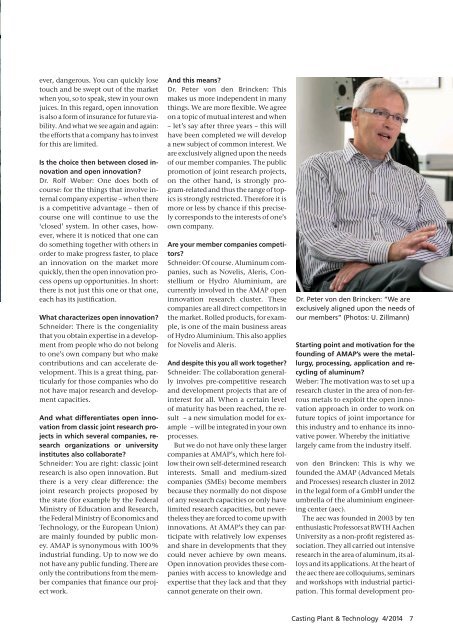CPT International 04/2014
The leading technical journal for the global foundry industry – Das führende Fachmagazin für die weltweite Gießerei-Industrie
The leading technical journal for the
global foundry industry – Das führende Fachmagazin für die
weltweite Gießerei-Industrie
Create successful ePaper yourself
Turn your PDF publications into a flip-book with our unique Google optimized e-Paper software.
ever, dangerous. You can quickly lose<br />
touch and be swept out of the market<br />
when you, so to speak, stew in your own<br />
juices. In this regard, open innovation<br />
is also a form of insurance for future viability.<br />
And what we see again and again:<br />
the efforts that a company has to invest<br />
for this are limited.<br />
Is the choice then between closed innovation<br />
and open innovation?<br />
Dr. Rolf Weber: One does both of<br />
course: for the things that involve internal<br />
company expertise – when there<br />
is a competitive advantage – then of<br />
course one will continue to use the<br />
‘closed’ system. In other cases, however,<br />
where it is noticed that one can<br />
do something together with others in<br />
order to make progress faster, to place<br />
an innovation on the market more<br />
quickly, then the open innovation process<br />
opens up opportunities. In short:<br />
there is not just this one or that one,<br />
each has its justification.<br />
What characterizes open innovation?<br />
Schneider: There is the congeniality<br />
that you obtain expertise in a development<br />
from people who do not belong<br />
to one’s own company but who make<br />
contributions and can accelerate development.<br />
This is a great thing, particularly<br />
for those companies who do<br />
not have major research and development<br />
capacities.<br />
And what differentiates open innovation<br />
from classic joint research projects<br />
in which several companies, research<br />
organizations or university<br />
institutes also collaborate?<br />
Schneider: You are right: classic joint<br />
research is also open innovation. But<br />
there is a very clear difference: the<br />
joint research projects proposed by<br />
the state (for example by the Federal<br />
Ministry of Education and Research,<br />
the Federal Ministry of Economics and<br />
Technology, or the European Union)<br />
are mainly founded by public money.<br />
AMAP is synonymous with 100 %<br />
industrial funding. Up to now we do<br />
not have any public funding. There are<br />
only the contributions from the member<br />
companies that finance our project<br />
work.<br />
And this means?<br />
Dr. Peter von den Brincken: This<br />
makes us more independent in many<br />
things. We are more flexible. We agree<br />
on a topic of mutual interest and when<br />
– let’s say after three years – this will<br />
have been completed we will develop<br />
a new subject of common interest. We<br />
are exclusively aligned upon the needs<br />
of our member companies. The public<br />
promotion of joint research projects,<br />
on the other hand, is strongly program-related<br />
and thus the range of topics<br />
is strongly restricted. Therefore it is<br />
more or less by chance if this precisely<br />
corresponds to the interests of one’s<br />
own company.<br />
Are your member companies competitors?<br />
Schneider: Of course. Aluminum companies,<br />
such as Novelis, Aleris, Constellium<br />
or Hydro Aluminium, are<br />
currently involved in the AMAP open<br />
innovation research cluster. These<br />
companies are all direct competitors in<br />
the market. Rolled products, for example,<br />
is one of the main business areas<br />
of Hydro Aluminium. This also applies<br />
for Novelis and Aleris.<br />
And despite this you all work together?<br />
Schneider: The collaboration generally<br />
involves pre-competitive research<br />
and development projects that are of<br />
interest for all. When a certain level<br />
of maturity has been reached, the result<br />
– a new simulation model for example<br />
– will be integrated in your own<br />
processes.<br />
But we do not have only these larger<br />
companies at AMAP’s, which here follow<br />
their own self-determined research<br />
interests. Small and medium-sized<br />
companies (SMEs) become members<br />
because they normally do not dispose<br />
of any research capacities or only have<br />
limited research capacities, but nevertheless<br />
they are forced to come up with<br />
innovations. At AMAP’s they can participate<br />
with relatively low expenses<br />
and share in developments that they<br />
could never achieve by own means.<br />
Open innovation provides these companies<br />
with access to knowledge and<br />
expertise that they lack and that they<br />
cannot generate on their own.<br />
Dr. Peter von den Brincken: “We are<br />
exclusively aligned upon the needs of<br />
our members” (Photos: U. Zillmann)<br />
Starting point and motivation for the<br />
founding of AMAP’s were the metallurgy,<br />
processing, application and recycling<br />
of aluminum?<br />
Weber: The motivation was to set up a<br />
research cluster in the area of non-ferrous<br />
metals to exploit the open innovation<br />
approach in order to work on<br />
future topics of joint importance for<br />
this industry and to enhance its innovative<br />
power. Whereby the initiative<br />
largely came from the industry itself.<br />
von den Brincken: This is why we<br />
founded the AMAP (Advanced Metals<br />
and Processes) research cluster in 2012<br />
in the legal form of a GmbH under the<br />
umbrella of the aluminium engineering<br />
center (aec).<br />
The aec was founded in 2003 by ten<br />
enthusiastic Professors at RWTH Aachen<br />
University as a non-profit re gistered association.<br />
They all carried out intensive<br />
research in the area of aluminum, its alloys<br />
and its applications. At the heart of<br />
the aec there are colloquiums, seminars<br />
and workshops with industrial participation.<br />
This formal development pro-<br />
Casting Plant & Technology 4/<strong>2014</strong> 7


















